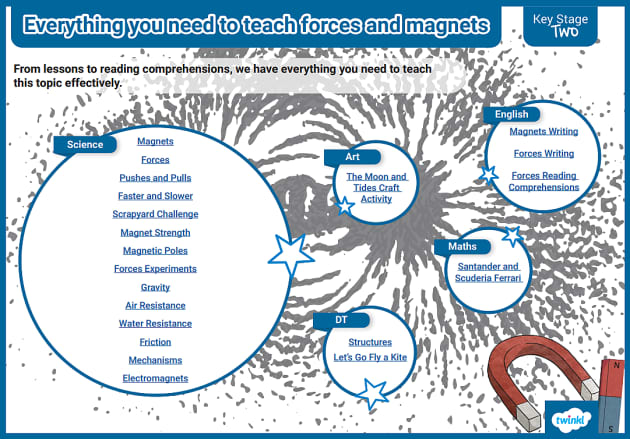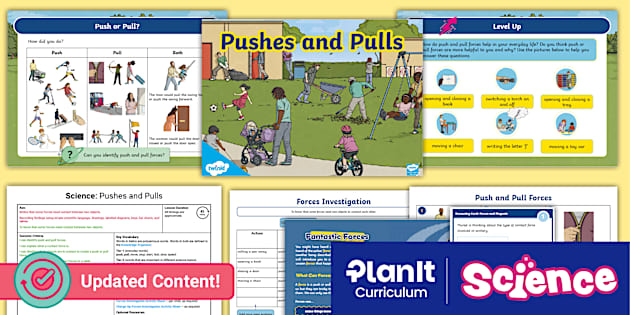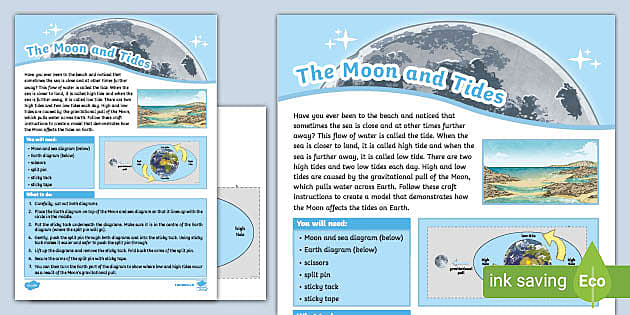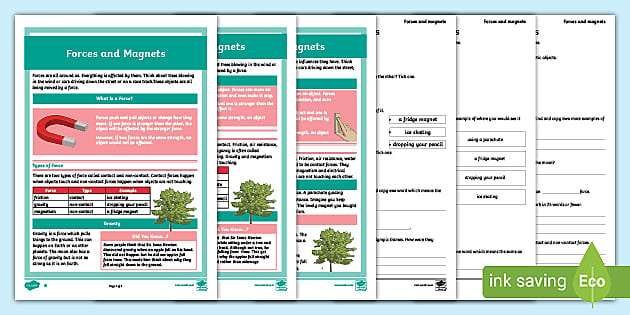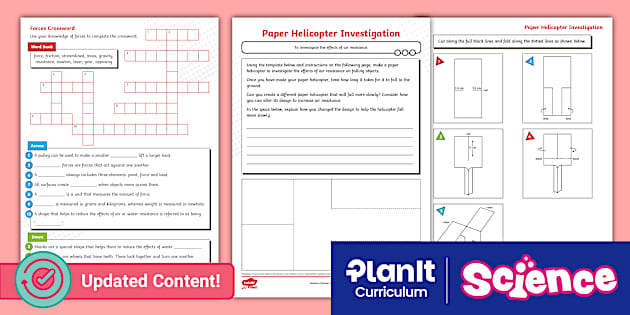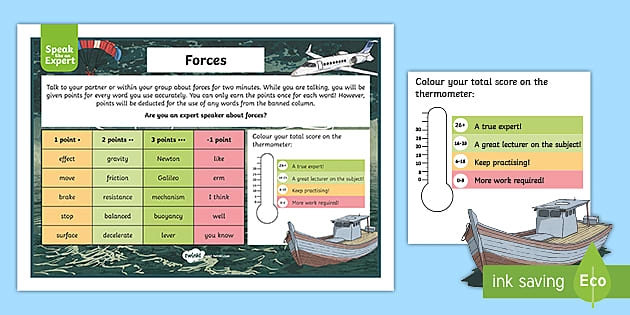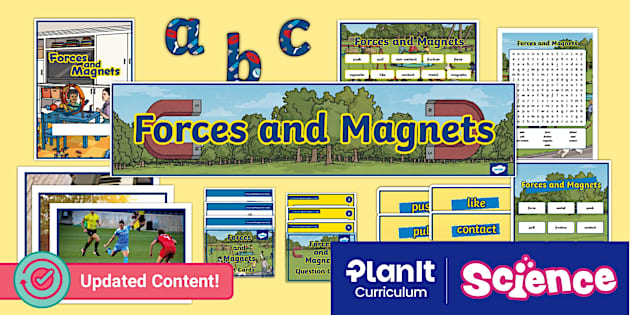


10 min
June 1, 2023
This useful blog is ideal for those who are planning on teaching forces and magnets to children in KS2. It features a diverse range of resources created by our fantastic team of experienced teachers.
You may not be able to see forces, but we are surrounded by them. Just like Sir Isaac Newton, who legend has it discovered the force of gravity after an apple bothered him by falling on his head, we can notice their effects. Using our lovely collection of teacher-made resources, your young learners will have the opportunity to learn about a diverse range of forces, such as:
Forces and magnets are taught together because magnets have their very own force, the force of magnetism. Your young learners are probably already familiar with the basic principles of magnetism, as they are a common household item. Your pupils might have seen them used to stick their drawings onto the family fridge or used them to connect the carriages of their toy trains. But did they know that the Earth itself is, in fact, a giant magnet powered by its liquid iron core? This fascinating topic gives your pupils the chance to learn all about the properties of magnets, their uses and much more.
#1 Science: Forces and Magnets: Pushes and Pulls Year 3 Lesson Pack 1
If you’re about to embark on teaching forces and magnets to children, then you might like to get started with a lesson dedicated to the simple concept of pushes and pulls. This teacher-made lesson pack contains everything you need to plan and deliver an engaging lesson. You’ll find:
To check for prior knowledge, you might like to give your pupils the opportunity to share their own experiences of using magnets to create pushes and pulls. For example, do they have any toys which make use of magnets, such as trains with carriages?
#2 KS2 The Moon and Tides Craft Activity
Combine science and art with this creative craft activity that will help pupils to better understand how the gravitational pull of the moon directly affects our ocean tides, pulling the water across the Earth. This resource includes a box outlining everything that your pupils will need for this craft activity, making planning and preparation simpler.
After reading a short passage together which explains the science behind low tide and high tide, your pupils will be challenged to create an eye-catching model of this process. Children will also strengthen their reading comprehension skills as they carefully follow the step-by-step instructions to create their models. For further support, pupils will also find cutting guidelines and a clear key. Once complete, these lovely models would make a brilliant addition to a classroom display of your pupils’ own work.
#3 DT: Marbulous Structures UKS2 Unit Pack
Use this fantastic unit pack to teach your class all about force and motion. Pupils will be given the chance to design and build their very own marbulous marble run. The design process and the experiments they’ll undertake using them will help your pupils to develop a stronger understanding of the force of gravity. They’ll also learn all about the strength, reinforcement and stability needed to create a freestanding structure. This unit pack includes:
#4 LKS2 Forces and Magnets Differentiated Reading Comprehension Activity
This lovely cross-curricular comprehension activity will help children further develop their understanding of forces and magnets whilst brushing up on an array of literacy skills, such as reading comprehension, handwriting, spelling and grammar.
We understand that you’re always looking for ways to tailor teaching and learning to the individual needs and abilities of the different pupils in your class. That’s why this resource, created by our team of experienced teachers, features three levels of differentiation for both the texts and corresponding question sheets. You’ll also find answer sheets for ease of marking.
Each level of differentiation is indicated with our simple star system, three stars being the most challenging. No matter which level of differentiation is selected, each text defines what a force is and covers at least three different types of forces, such as friction, gravity and magnetism.
#5 Science: Forces Year 5 Home Learning Tasks
Give your young scientists the opportunity to consolidate their classroom knowledge with these exciting home learning tasks. It includes a themed forces crossword and a helicopter investigation. The crossword includes a support box filled with topic-specific vocabulary, such as resistance, mass and gravity, to help jog your pupils’ memory. If they’d like a little more challenge, they can simply cover up this box. There are ten questions in total.
To conduct their helicopter investigation, pupils must first follow the instructions, a combination of words and visual aids, to create their paper helicopter. This process is a great way to boost their comprehension and fine motor skills. It can also boost their resilience and problem-solving skills, as if it doesn’t work out the first time, they’ll need to take it back a step and try again.
Once they’ve made their paper helicopters, children will be asked to drop it to the ground and time its descent. Next, using their understanding of gravity and resistance, they’ll be challenged to create a new paper helicopter that falls more slowly.
There is a large box for pupils to draw a picture of their new paper helicopter in, before using the handwriting guidelines below to explain their process. What changes did they make when making their second helicopter and why? Was it slower than the first? When your pupils hand in their homework, you might like to remind them that even when an experiment doesn’t yield the results you were aiming for, there’s still lots to be learned.
#6 KS2 Speak like an Expert Challenge Card: Forces
Public speaking, about any topic, is a valuable and transferable skill which your pupils will benefit from right into adulthood. Active listening skills are equally as important as the ability to speak well. Active listening ensures that pupils gain as much valuable information as possible when listening to a speaker.
This fantastic set of Speak like an Expert Challenge Cards will help your pupils to develop both their public speaking skills and their active listening skills. Pupils will be challenged to talk for 2 minutes on the topic of forces, whilst including as much topic-specific vocabulary as possible.
Ideal for visual learners, a colour coded point system will award points for the use of this vocabulary. Points will be deducted for mumbles and colloquialisms such as ‘well’ ‘erm’ and ‘you know’. Afterwards, pupils will use their points to colour in a thermometer, which will give them a score. The scores on the lower end have been worded to encourage a growth mindset, focusing on what pupils need to do in order to succeed in the future. These scores are:
#7 Science: Forces and Magnets Year 3 Unit Additional Resources
Updating your classroom displays and learning walls is a great way to get children excited about a new topic. Learning walls can also provide your pupils with valuable information and encourage the development of independent learning strategies.
So, if you’re planning on teaching forces and magnets to children in KS2, you might want to check out the array of display materials in this pack. You’ll find informative and eye-catching posters and fact cards. There are also beautifully illustrated banners and themed lettering to help you add the finishing touches to your displays.
Are you looking for engaging starter activities to help get your pupils excited to learn all about forces and magnets? Perhaps you need some topic-specific extension tasks for your fast finishers? Then check out the themed word searches in this handy pack of additional resources!
#8 Forces and Magnets Board Game
Children learn brilliantly through play. So, educational board games are a great way to capture their attention and keep them engaged with learning. If you’re teaching forces and magnets to children, we recommend this lovely board game which is suitable for use in pairs or groups of up to four.
Twinkl Tip: Laminate your board game and question cards, so they can be enjoyed again and again. This is also a handy way to reduce the amount of paper waste which is sent to landfill each year.
Are you aiming to take a cross-curricular approach to teaching forces and magnets to children in KS2? Then allow us to introduce you to our wider collection of teacher-made resources from this topic. From racing-themed maths resources to beautifully illustrated page borders for extended writing tasks, we’ve got you covered. You can also refresh your topic knowledge ahead of time with our handy Twinkl Teaching Wikis dedicated to forces and magnets, respectively.
If you enjoyed this blog all about teaching forces and magnets to children in KS2, why not take a peek at our wider range of topic-related blogs? Here’s a small sample that we’ve put together just for you:
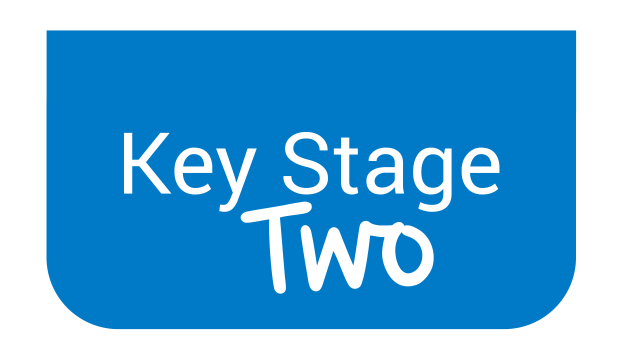
The KS2 Segment Team are passionate about providing everything you need, allowing you time to teach. They create content tailored to support all KS2 teachers with their preparation, planning and assessment, allowing you time to focus on what matters most - the children.
Follow them on Twitter @TwinklKS2 for up-to-date news, Facebook @TwinklKS2 for the latest content, TikTok @TwinklKS2 for some teacher related humor, Pinterest @TwinklKS2 for creative lesson ideas and Instagram @TwinklKS2 for some fun lesson inspiration!
